“Water for biodiversity” International Congress of Limnology
August 30th, 2016
Researchers from Instituto Fomento Pesquero (IFOP) attend to the event. The target of the conference is to be a unifying unit of different efforts, both national and international, oriented to the study of continental waters. This is intended to create a productive environment for interdisciplinary exchange of ideas, results and job prospects.
Between 21 and 25 August at Hilton Tucuman hotel in Argentina, the VII Congress of Limnology will be held, whose slogan is “Water for biodiversity.” It is organized by the Neotropical Biodiversity Institute of Argentina (CONICET-UNT).
Dr. Claudia Perez and Carolina Oyarzo will present the work: Capacity in Araucanian lakes with aquaculture activity and environmental assessment of humic lakes in southern Chile.
Claudia Pérez Sáez, is a Marine Biologist and PhD in Environmental Sciences at Universidad de Concepción; her area of interest is the study of biogeochemical processes in marine and freshwater systems, influenced by different anthropogenic factors. She is part of environmental group of IFOP Puerto Montt, performing evaluation tasks of environmental state of lakes.
Carolina Oyarzo Rosner is an Aquaculture Engineer of Universidad Austral and Master’s degree in Aquaculture, Resources, Impact and Management of the University of Genoa (Italy), her interest has focused on the Limnology area, investigating the environmental status and load capacity of the lakes that have been used in aquaculture activities.
ISSUES PRESENTED BY IFOP RESEARCHERS
Both contributions arise from the work being carried out by Instituto de Fomento Pesquero in the lakes of southern Chile, which are utilized for aquaculture, and from this, knowledge and information oriented to the sustained use of this water bodies.

Load capacity in Araucanian lakes with aquaculture activity (Carolina Oyarzo Rosner Pesse Nicole and Claudia Perez).
The Araucanian lakes are located in basins of the western watershed of Andes Mountain, between 39° S and 42°S. They have volcanic origin, deep, large, and with vast volume of water. They have historically been described with high transparency, low nutrient supply and low primary production. Its original oligotrophy has enabled a wide range of activities undertaken by human being, which contribute with nutrient inputs to aquatic systems, accelerating the process of nutrient enrichment (eutrophication). In this study, loading capacity is evaluated from five Araucanian lakes: Ranco, Puyehue, Rupanco, Llanquihue, and Chapo, by means of the model of the OECD (1982). To do this, land use maps were generated in each basin, estimating later the hydrological balance. Subsequently, the phosphorus (PT) nutrient balance, current and critical load of each lake were calculated. According to the results, the predominant use of soil in the lake system is the native forest, being the Llanquihue Lake the one with most anthropic activity (human).
Environmental assessment of humic lakes in southern Chile (Claudia Pérez Saéz, Carolina Oyarzo, Nicole Pesse).
Humic lakes are aquatic systems which are characterized by high concentrations of dissolved organic material colored (CDOM, according its acronym in Spanish) of allochthonous origin (from elsewhere). These contributions provoke alterations in lake systems, restricting the light penetration into the water column. Currently, the natural conditions of these lacustrine systems are being modified because of different anthropogenic pressures in the basin and water body. That is why the aim of this study is to assess the current environmental quality of humic lakes. Six lakes were sampled: (Popetán, Cucao, Huillinco, Tarahuín, Natri, Tepuhueico) of Chiloe Island (42°S); two sampling campaigns were carried out (winter and summer) in most cases. Assessing water column (transparency, temperature, oxygen, conductivity, total nitrogen, ammonium, nitrite, nitrate, total phosphorus, and orthophosphate, color, CDOM, abundance and phytoplankton composition) and sediment (organic matter, pH, redox potential) of each lake. Monomictic characteristics were recorded in most lakes. When evaluating hypertrophy parameters, transparency showed a eutrophic condition in all cases related to the abundant CDOM and high color. Meanwhile, nutrients showed critical situations in all lake systems, while chlorophyll concentrations indicated a mostly oligotrophic state. Phytoplankton composition was characterized by low diversity. Regarding sediment characteristics, in most cases, these show high concentrations of organic matter. These lacustrine bodies presented a highly sensitive condition to anthropic interventions.
